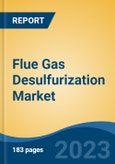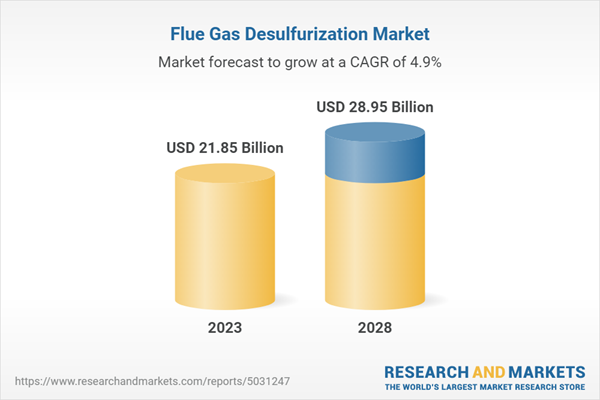Free Webex Call
The Global flue gas desulfurization market is anticipated to grow at a steady pace in the forecast period, 2023-2028. The global flue desulfurization system market is being driven by rising demand in the cement and chemical manufacturing industries. Flue gas desulfurization market is rising due to governments' growing awareness of ecological balance and global warming. To effectively remove gases from industrial facilities, market participants are working to diversify their product lines. Additionally, the global implementation of IMO 2020, beginning in January 2020, is anticipated to present an opportunity in the market for flue gas sulfurization. Speak directly to the analyst to clarify any post sales queries you may have.
10% Free customizationThis report comes with 10% free customization, enabling you to add data that meets your specific business needs.
Moreover, a collection of techniques known as flue gas desulfurization (FGD) are employed in operations that release sulphur oxide, including coal-fired boilers, paper and pulp mills, diesel generators, oil-fired boilers, and waste incinerators, to remove sulphur dioxide from exhaust flue gases. Spray towers, chemical absorption towers, and venturi rod absorbers are all components of the wet flue gas desulfurization system. Two components of dry and semi-dry flue gas desulfurization systems are a baghouse filter and a spray dryer.
Standards to Reduce SOx Emission are Fueling the Market Growth
Around 95% of sulphur is thought to be transformed into Sulphur dioxide at ordinary temperature levels. Therefore, there is a continuing need to reduce Sulphur emissions through controlling industrial emissions, which necessitates the use of various flue gas desulphurization systems.Additionally, implementation of stringent air quality standards to reduce SOx emission levels is anticipated to drive market growth over the forecast period. For instance, to remove SO2 from gases produced by furnaces, boilers, and other sources, Mitsubishi Hitachi Power Systems, Ltd. supplies flue desulfurization equipment which is a wet limestone-gypsum flue desulfurization. . Owing to which the market is expected to grow with a high CAGR in the forecast period.
Companies are anticipated to be encouraged to construct FGD systems in their power plants due to the high market demand for FGD gypsum. Gypsum from FGD is used in a variety of industries, such as agriculture, building highways, creating gypsum panels, mining, treating water, making cement and glass. In a variation of soil situations, it is employed as a soil amendment. In addition, wallboard, cement, and plaster of Paris are all produced using FGD by-products. Due to which the need of Flue Gas Desulfurization is increasing day by day.
Stricter environmental restrictions have been assigned to the global flue gas desulfurization (FGD) market. A rigid demand for flue gas desulfurization has been created by the world's escalating energy demand. Plants near beaches are being affected by sea-water FGD. Sea water is a natural source of salt that can be utilized profitably to remove SO2 from flue gas without the need for any additional chemical agents. In addition to the electricity and production industries, water transportation has recently been added to the list of sources of air pollution. To reduce it, the government is taking actions towards less air pollution and people are adopting FGD.
Rising Electricity Consumption in Asian Countries
The main sources of SO2, mercury, and acid gas emissions are power plants. About 98% of SO2, 94% of mercury, 86% of NOx, and 83% of fine particle emissions in the power sector are caused by coal. About 38% of the world's electricity is produced by coal as of 2018. The private energy producers favor coal over pure natural gas because it is more readily available and easier to transport. The extensive usage of coal causes global warming and toxic pollution of the environment, due to this fact people are moving towards FGD.It is anticipated that rising electricity consumption will spur market expansion, along with large investments in thermal power facilities in Asian nations. For example, China has established a variety of goals to expand the amount of non-fossil fuels in the country's energy mix by 15%, which will limit the expansion of the FGD market by maintaining the country's coal power capacity at 1.1 TW. However, the Chinese government has ignored worries about financial viability, overcapacity, and the environment in favor of investing in the economy and moving towards energy security, which is likely to boost the product demand over the projection period.
Rising Investments in Thermal Power Plants
Along with considerable investments in thermal power plants in Asian nations, the rising demand for electricity is anticipated to stimulate. The design of high-performing FGD systems would benefit from technical advancement in today's modern environment, giving market participants additional options to investigate. Furthermore, the cost of FGD systems is being reduced and estimated to open prospects for new market entrants.In recent years, the dry FGD method has evolved into a multi-pollutant (Hg, HF, HCl, SO3) control technology. They are heavily utilized in large-scale power plants due to the development of more effective dry scrubber technologies, like NID and CFB-FGD. According to the American Coal Ash Association, the dry FGD by-product was used in the U.S. for more than 25% of the year, 2018.
High Maintenance Cost Restraining the Market Growth
A significant market barrier is the high maintenance costs brought by the need for several reagents to reduce Sulphur emissions. The tank agitation, reheater, water, and slurry pumps are responsible for using the majority of the energy. Scrubber design, governmental restrictions, and coal properties are other major variables that affect patterns of energy usage. These significant energy needs present a significant barrier to the development of Flue Gas Desulfurization (FGD) Market.Market Segmentation
The global flue gas desulfurization market is segmented based on type, end user, and installation. Based on type, the market is segmented into wet FGD systems, spray dry FGD system, dry & semi-dry FGD systems. Based on end user, the market is segmented into power generation, cement, chemical, iron and steel, and others. Based on installation, the market is segmented into greenfield and brown field. Based on region, the market is segmented into North America, Asia-Pacific, Europe, South America, and the Middle East.Market Players
Major market players in the global flue gas desulfurization market are Alstom S.A, Andritz AG, Babcock & Wilcox Enterprises Inc, Ducon Technologies Inc, Fujian Longking Co. Ltd, General Electric Company, Hamon Corporation, John Wood Group PLC, Mitsubishi Hitachi Power Systems Ltd, and Thermax Ltd.Report Scope:
In this report, the Global Flue Gas Desulfurization Market has been segmented into following categories, in addition to the industry trends which have also been detailed below:Flue Gas Desulfurization market, By Type:
- Wet FGD Systems
- Spray Dry FGD System
- Dry & Semi-dry FGD Systems
Flue Gas Desulfurization market, By Installation:
- Power Generation
- Cement
- Chemical
- Iron and Steel
- Others
Flue Gas Desulfurization market, By End User:
- Greenfield
- Brown Field
Flue Gas Desulfurization market, By Region:
- North America
- United States
- Canada
- Mexico
- Asia-Pacific
- China
- India
- Japan
- South Korea
- Indonesia
- Europe
- Germany
- United Kingdom
- France
- Russia
- Spain
- South America
- Brazil
- Argentina
- Middle East
- Saudi Arabia
- South Africa
- UAE
- Israel
Competitive Landscape
Company Profiles: Detailed analysis of the major companies present in Global Flue Gas Desulfurization market.Available Customizations:
Global Flue Gas Desulfurization Market report with the given market data, the publisher offers customizations according to a company's specific needs.This product will be delivered within 1-3 business days.
Table of Contents
1. Product Overview
2. Research Methodology
5. Global Flue Gas Desulfurization Market Outlook
6. North America Flue Gas Desulfurization Market Outlook
7. Asia-Pacific Flue Gas Desulfurization Market Outlook
8. Europe Flue Gas Desulfurization Market Outlook
9. South America Flue Gas Desulfurization Market Outlook
10. Middle East & Africa Flue Gas Desulfurization Market Outlook
11. Market Dynamics
13. Company Profiles
Companies Mentioned
- Alstom S.A
- Andritz AG
- Babcock & Wilcox Enterprises Inc
- Ducon Technologies Inc
- Fujian Longking Co. Ltd
- General Electric Company
- Hamon Corporation.
- John Wood Group PLC
- Mitsubishi Hitachi Power Systems Ltd
- Thermax Ltd
Table Information
| Report Attribute | Details |
|---|---|
| No. of Pages | 183 |
| Published | October 2023 |
| Forecast Period | 2023 - 2028 |
| Estimated Market Value ( USD | $ 21.85 Billion |
| Forecasted Market Value ( USD | $ 28.95 Billion |
| Compound Annual Growth Rate | 4.8% |
| Regions Covered | Global |
| No. of Companies Mentioned | 10 |









